Nov 6 2023
Storytelling as Pedagogy: Building Immersive Learning Journeys

VP Learning Solutions

Nov 6 2023

VP Learning Solutions

Stories have been widely used throughout the ages to teach moral values to children. When technology revolutionizes the education sector, it should focus on strengthening the best pedagogical strategies. The art of storytelling builds on the imagination of students and enriches their learning experience. Effective story-based learning cycles in K12 education will enable children to think and learn beyond the story script. It will lead students to explore relevant issues to make their learning more memorable. Story-based learning will develop learners’ ability to use higher-order thinking skills to enhance creative thinking and analyzing skills.
Whether used in traditional classrooms or virtual learning spaces, schools can leverage story-based learning to offer the following benefits to the students:
Storytelling follows the same tried and tested framework. The listeners follow a protagonist who is a good guy, overcomes challenges, overcomes the villains, and emerges as a worthy hero. The story-based learning methodology encourages students to relate to and get inspired by the hero. Educational publishers can also extend storytelling to corporate learners to teach technical and soft skills. There are four basic story types:
The teacher must use storytelling as a teaching methodology to inspire students using real-life stories. The story must mirror the reality of the students, and they must be able to relate to the characters and their life situations. The plot must contain chronological events and engage the students throughout the learning process.
The instructional designers of educational publishers can create story-based online learning courses that resonate with the target audience. The instructional designers must collaborate with subject matter experts (SMEs) to create meaningful and impactful stories to ensure contextualization.
Over 30% of American students are enrolled in at least one online course. In the K12 education landscape, combining storytelling with scenario-based learning and interactivities will not only keep the students engaged but will also encourage them to actively participate in the learning process. Some of the best practices for designing story-based learning experiences are:
Clearly define what you want your learners to achieve through the learning experience. Specifying the learning outcomes will enable the instruction designers to create a compelling storyline tailored to the audience.
The purpose of stories in the learning environment is to encourage learning and engagement. The story used in the storytelling methodology must align with the learning objectives and relate to the audience. The characters and situations used in the story must be related to the content you want to teach. Also, they must reflect the audience, their culture, and their preferences.
Develop memorable and relatable characters that the learners can connect with. The characters should have distinct personalities and traits that reflect the target audience. Only then will the audience get immersed in the story narrative.
Create an interesting narrative plot that learners can follow along with. Build the plot around the learning content with a clear beginning, middle, and end. You must make the plot interesting with conflicts and resolutions illustrating key learning concepts.
Include the learning objectives and key concepts within the story narrative. They will enforce learning while the students listen to the stories.
Make the story vibrant with multiple multimedia elements such as images, videos, and audio relevant to the story. It will increase the engagement of the audience.
Creating open-ended stories where the learners can participate in the story narration will increase their involvement and engagement. Include interactivities where the users can choose a path, and the story will move forward based on their choice. Incorporating learning objectives through interactivities will give the learners hands-on experience via story scenarios.
To reinforce learning concepts, provide immediate feedback to the learners and make them understand the consequences of their decisions. This is important to ensure a complete understanding of the learned concepts.
Offering assessment modules as quizzes will not only keep students engaged throughout the learning process but will also increase comprehension of the story and the learning material.
Giving multiple paths for the story will personalize the story-based learning experience for each student. The students will understand that different choices will lead to different outcomes. It will enhance the critical thinking and curiosity of the students.
The popularity of online courses is rising among the new generation of learners. A recent survey showed that 52% of graduate students in the US found online college-level education enhanced their learning experience compared to classroom education. Educational publishers can improve the functionalities of their learning management systems with storytelling. Some ways EdTech companies can incorporate storytelling into their learning experience platforms are:
Storytelling in online courses can make the learning experience memorable, enjoyable, and effective. Gripping stories crafted using rich multimedia will create an immersive learning environment that fosters creativity and critical thinking. Students will also gain a sense of accomplishment as they complete increasingly difficult challenges as a part of story narration. The accomplishments increase student engagement and motivation, especially when they learn abstract concepts in K12 education. Story-based online learning is useful for promoting an effective understanding of heavy concepts in an interesting and refreshing way.
Leave A Reply
Your email address will not be published. Required fields are marked *